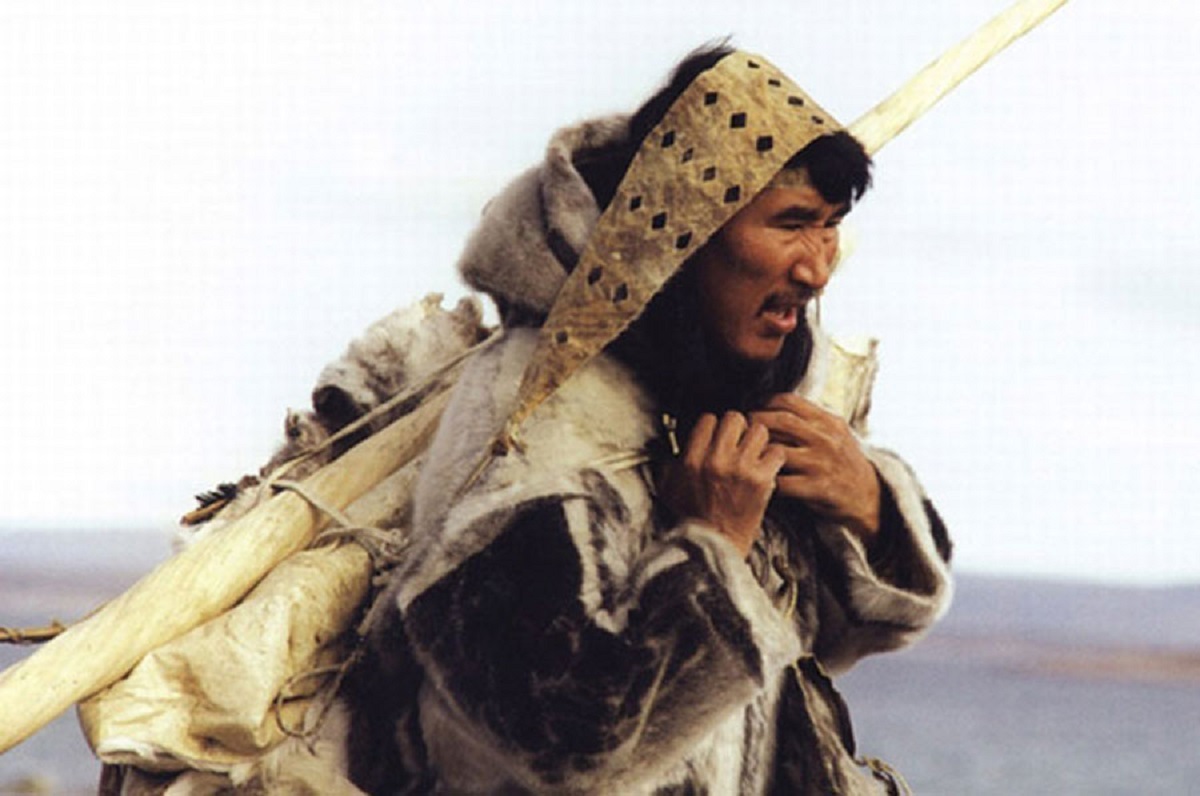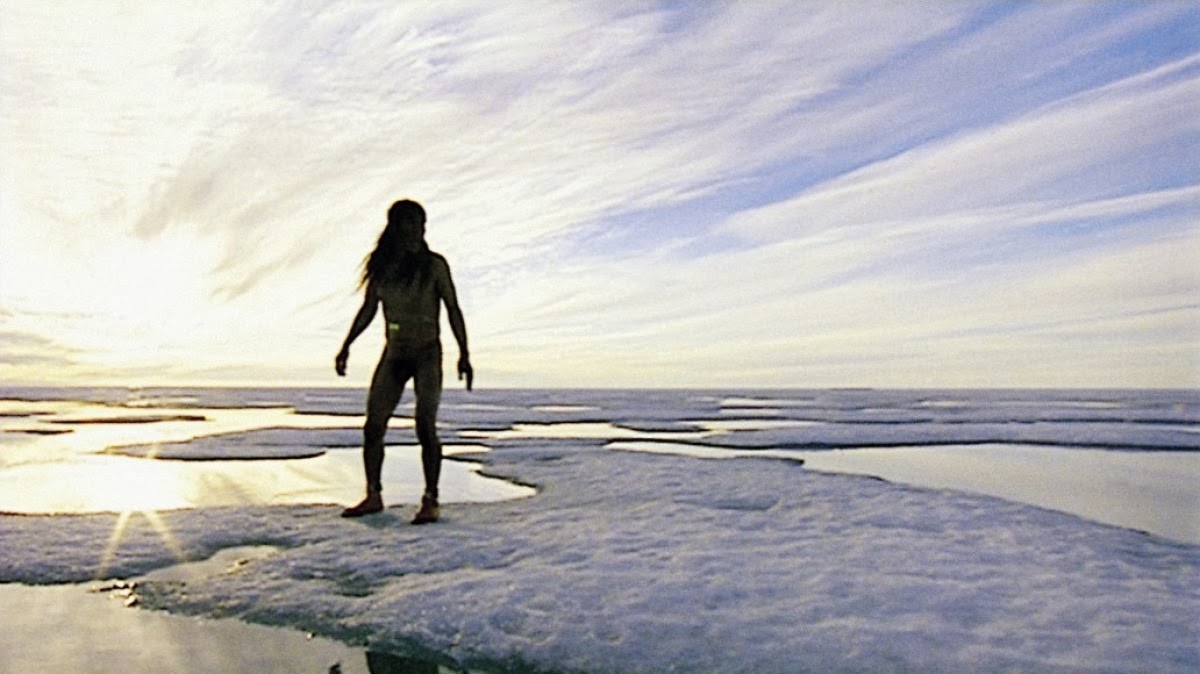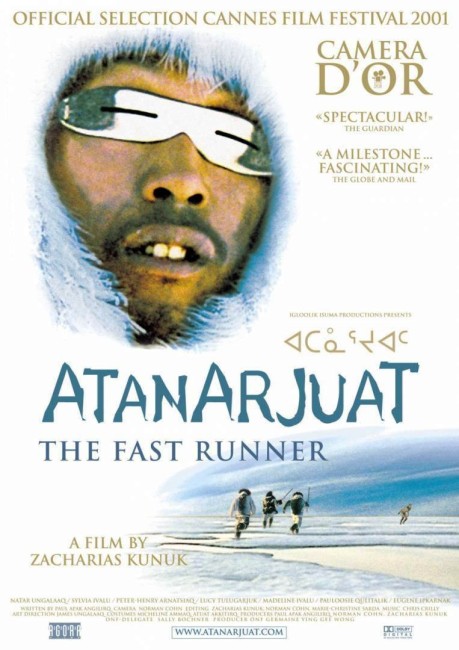Canada. 2001.
Crew
Director – Zacharias Kunuk, Screenplay – Paul Apak Angilirq, Producers – Paul Apak Angilirq, Zacharias Kunuk & Norman Cohn, Photography – Norman Cohn, Music – Chris Crilly, Design – James Ungalaaq. Production Company – Igloolik Isuma Productions/The National Film Board of Canada.
Cast
Natar Ungalaaq (Atanarjuat), Sylvia Ivalu (Atuat), Peter-Henry Arnatsiaq (Oki), Lucy Tulugarjuk (Puta), Pauloosie Qulitalik (Qulitalik), Madeline Ivalu (Panikpak), Pakkak Innukshuk (Amaqjuaq), Eugene Ipkarnak (Sauri)
Plot
In the far frozen north of the Arctic Circle, the chief Sauri and his bullying sons dominate a small tribe of Inuit. When one tribe member Atanarjuat falls in love with the beautiful Atuat, this angers Sauri’s son Oki to whom Atuat has been promised. However, Atanarjuat wins Atuat fairly in a fight for her hand against Oki and they are married. With Atuat pregnant, Atanarjuat must depart to go seal hunting over the spring and takes Sauri’s daughter Puta to accompany him, making her his second wife. However, after returning to the encampment, Puta, while graciously accepted by Atuat, commits the crime of sleeping with Atanarjuat’s brother Amaqjuaq. Puta then tells her family that Atanarjuat tried to kill her. Oki swears to kill Atanarjuat and pursues him naked across the ice for miles, although Atanarjuat eventually escapes. Returning, Oki kills Sauri and usurps leadership of the tribe, after which he treats Atuat with disdain. Atanarjuat bides his time waiting to return and confront with the spirit of evil that has come upon his tribe.
The Inuit, or to give them their English name The Eskimo, have always been an interesting culture. Originating in Alaska, the Inuit people migrated across Canada and even as far as Greenland around the first millennium to eventually inhabit the entire North American Arctic. The Inuit have a unique culture in that it is one lived almost entirely around hunting Arctic animals (whales, seal, caribou, fish) and has little in the way of any vegetable diet, and also in that it was a culture that developed without the employment of iron until European contact in the 19th Century. On film, the Inuit have been represented by the likes of the classic documentary Nanook of the North (1922), Philip Kaufman’s White Dawn (1976) and with interesting, although not entirely successful artistic ambition, in Vincent Ward’s Map of the Human Heart (1993). Subsequent to this, there was also Disney’s animated Brother Bear (2003).
Atanarjuat: The Fast Runner is one of these rare additions to Inuit cinema. It adds an entire new dimension to anything that has been attempted before. It comes, supported by the National Film Board of Canada, from a production company that has been formed by Inuit peoples. Not only is it shot in the Arctic Circle town of Igloolik (near Baffin Island) but is entirely cast, crewed, written, directed and produced by native Inuit people. All the dialogue comes in the native Inuktitut language.

Moreover, the filmmakers have made all effort to evoke a painstaking realism. Atanarjuat: The Fast Runner could be set in any time period but it has been deliberately stripped of all elements of European culture – everything we see on screen is handmade and crafted in the way it would have been pre-European contact. The filmmakers even went to the notebooks of Admiral William Perry’s British Naval expedition to Igloolik in 1822-3 to obtain an authentic picture of the untouched Inuit culture.
Though based on an Inuit legend, the plot of Atanarjuat: The Fast Runner is in essence not that different to the cod anthropological cliches of films such as One Million Years B.C. (1966) and Creatures the World Forgot (1971) – the tribe is taken over by the bad seed inheritor, the good hero is driven out to make a triumphant return after various travails in the wilderness, the hero is drawn between one good and loving woman and a calculating strumpet. That said, Atanarjuat develops a complex and very moving story out of the material. It is not a story that is always clear in subtitles – it takes some time for the intricacies of Inuit multiple marriage to become apparent and it is not apparent until the end why Puta is telling her brothers that Atanarjuat tried to kill her.
Zacharias Kunuk directs long scenes. Sometimes this is so that he can show us every facet of Inuit culture – we get detailed lessons in building igloos, in using sharpened stone to strip whale meat and some fascinating scenes where disputes are settled by a fight where either combatant stands still and in turn lets their opponent measure a blow to their head and then deliver it.

The film’s visual and dramatic highlight is a long sustained sequence where three hunters pursued a naked Atanarjuat across miles and miles of empty snowy waste – the end credits reveal that this was a genuine feat of endurance that actor Natar Ungalaaq underwent for the role. The cast are often amateurs and most had never acted before but both the rawness of the performances and the detail with which Zacharias Kunuk dwells upon each scene evokes a rare depth and authenticity that is far and away from anything that any commercial cinematic equivalent might offer.
That one is looking into the past and seeing a story that might have happened and people that may have been there, Atanarjuat: The Fast Runner leaves one with no doubt whatsoever. The completeness of the vision and the real sense of pathos and emotion the actors engender in their roles has a rare ring of total authenticity.
Zacharias Kunuk, this time co-directing with Atanarjuat cinematographer/producer Norman Cohn, next went onto make The Journals of Knud Rasmussen (2006), detailing the meeting between Inuit and Europeans, and then solo directing Maluglutit/Searchers (2016) and One Day in the Life of Noah Piugattuk (2019).
(Winner in this site’s Top 10 Films of 2001 list. Nominee for Best Director (Zacharias Kunuk) and Best Actress (Sylvia Ivalu) this site’s Top 10 Films of 2001 list.)
Trailer here

